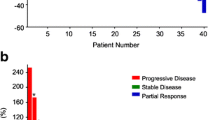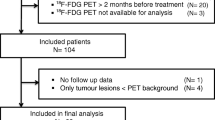Abstract
Purpose
FDG PET is effective in treatment response evaluation of cancer. However, there is no standard method for quantitative evaluation of FDG PET, particularly regarding cytostatic drugs. We compared various FDG PET quantitative methods in terms of response determination.
Methods
A total of 39 refractory metastatic colorectal cancer patients who received a multikinase inhibitor treatment were included. Baseline and posttreatment FDG PET/CT scans were performed before and two cycles after treatment. Standardized uptake value (SUV) and total lesion glycolysis (TLG) values using various margin thresholds (30–70 % of maximum SUV with increment 10 %, twice mean SUV of blood pool, SUV 3.0, and SUV 4.0) were measured, with measurement target of the hottest lesion or a maximum of five hottest lesions. Treatment response by the PERCIST criteria was also determined. Predictive values of the PET indexes were evaluated in terms of the treatment response determined by the RECIST 1.1 criteria.
Results
The agreement rate was 38 % between response determined by the PERCIST and the RECIST criteria (κ = 0.381). When patients were classified into disease control group (PR, SD) and non-control group (PD) by the RECIST criteria, percent changes of TLG with various margin thresholds (particularly, 30–50 % of maximum SUV) exhibited significant differences between the two groups, and high diagnostic power for the response by the RECIST criteria. TLG-based criteria, which used a margin threshold of 50 % of maximum SUV, exhibited a high agreement with the RECIST criteria compared with the PERCIST criteria (κ = 0.606).
Conclusion
In metastatic colorectal cancer, FDG PET/CT could be effective for treatment response evaluation by using TLG measured by margin thresholds of 30–50 % of maximum SUV. Further studies are warranted regarding the optimal cutoff values for this method.

Similar content being viewed by others
References
Eschmann SM, Friedel G, Paulsen F, Reimold M, Hehr T, Budach W, et al. Repeat 18F-FDG PET for monitoring neoadjuvant chemotherapy in patients with stage III non-small cell lung cancer. Lung Cancer. 2007;55:165–71.
Lin C, Itti E, Haioun C, Petegnief Y, Luciani A, Dupuis J, et al. Early 18F-FDG PET for prediction of prognosis in patients with diffuse large B-cell lymphoma: SUV-based assessment versus visual analysis. J Nucl Med. 2007;48:1626–32.
Berghmans T, Dusart M, Paesmans M, Hossein-Foucher C, Buvat I, Castaigne C, et al. Primary tumor standardized uptake value (SUVmax) measured on fluorodeoxyglucose positron emission tomography (FDG-PET) is of prognostic value for survival in non-small cell lung cancer (NSCLC): a systematic review and meta-analysis (MA) by the European Lung Cancer Working Party for the IASLC Lung Cancer Staging Project. J Thorac Oncol. 2008;3:6–12.
Benz MR, Czernin J, Allen-Auerbach MS, Tap WD, Dry SM, Elashoff D, et al. FDG-PET/CT imaging predicts histopathologic treatment responses after the initial cycle of neoadjuvant chemotherapy in high-grade soft-tissue sarcomas. Clin Cancer Res. 2009;15:2856–63.
Yanagawa M, Tatsumi M, Miyata H, Morii E, Tomiyama N, Watabe T, et al. Evaluation of response to neoadjuvant chemotherapy for esophageal cancer: PET response criteria in solid tumors versus response evaluation criteria in solid tumors. J Nucl Med. 2012;53:872–80.
Hatt M, van Stiphout R, le Pogam A, Lammering G, Visvikis D, Lambin P. Early prediction of pathological response in locally advanced rectal cancer based on sequential 18F-FDG PET. Acta Oncol. 2013;52:619–26.
Young H, Baum R, Cremerius U, Herholz K, Hoekstra O, Lammertsma AA, et al. Measurement of clinical and subclinical tumour response using [18F]-fluorodeoxyglucose and positron emission tomography: review and 1999 EORTC recommendations. European Organization for Research and Treatment of Cancer (EORTC) PET Study Group. Eur J Cancer. 1999;35:1773–82.
Wahl RL, Jacene H, Kasamon Y, Lodge MA. From RECIST to PERCIST: evolving considerations for PET response criteria in solid tumors. J Nucl Med. 2009;50 Suppl 1:122S–50.
Byun BH, Kong CB, Park J, Seo Y, Lim I, Choi CW, et al. Initial metabolic tumor volume measured by 18F-FDG PET/CT can predict the outcome of osteosarcoma of the extremities. J Nucl Med. 2013;54:1725–32.
Pak K, Cheon GJ, Nam HY, Kim SJ, Kang KW, Chung JK, et al. Prognostic value of metabolic tumor volume and total lesion glycolysis in head and neck cancer: a systematic review and meta-analysis. J Nucl Med. 2014;55:884–90.
Rahim MK, Kim SE, So H, Kim HJ, Cheon GJ, Lee ES, et al. Recent trends in PET image interpretations using volumetric and texture-based quantification methods in nuclear oncology. Nucl Med Mol Imaging. 2014;48:1–15.
Kurtipek E, Cayci M, Duzgun N, Esme H, Terzi Y, Bakdik S, et al. (18)F-FDG PET/CT mean SUV and metabolic tumor volume for mean survival time in non-small cell lung cancer. Clin Nucl Med. 2015;40:459–63.
Minamimoto R, Barkhodari A, Harshman L, Srinivas S, Quon A. Prognostic value of quantitative metabolic metrics on baseline Pre-Sunitinib FDG PET/CT in advanced renal cell carcinoma. PLoS One. 2016;11, e0153321.
Farnebo J, Gryback P, Harmenberg U, Laurell A, Wersall P, Blomqvist LK, et al. Volumetric FDG-PET predicts overall and progression- free survival after 14 days of targeted therapy in metastatic renal cell carcinoma. BMC Cancer. 2014;14:408.
Wong AL, Lim JS, Sinha A, Gopinathan A, Lim R, Tan CS, et al. Tumour pharmacodynamics and circulating cell free DNA in patients with refractory colorectal carcinoma treated with regorafenib. J Transl Med. 2015;13:57.
Findlay M, Young H, Cunningham D, Iveson A, Cronin B, Hickish T, et al. Noninvasive monitoring of tumor metabolism using fluorodeoxyglucose and positron emission tomography in colorectal cancer liver metastases: correlation with tumor response to fluorouracil. J Clin Oncol. 1996;14:700–8.
Bender H, Bangard N, Metten N, Bangard M, Mezger J, Schomburg A, et al. Possible role of FDG-PET in the early prediction of therapy outcome in liver metastases of colorectal cancer. Hybridoma. 1999;18:87–91.
Dimitrakopoulou-Strauss A, Strauss LG, Rudi J. PET-FDG as predictor of therapy response in patients with colorectal carcinoma. Q J Nucl Med Mol Imaging. 2003;47:8–13.
Dimitrakopoulou-Strauss A, Strauss LG, Burger C, Ruhl A, Irngartinger G, Stremmel W, et al. Prognostic aspects of 18F-FDG PET kinetics in patients with metastatic colorectal carcinoma receiving FOLFOX chemotherapy. J Nucl Med. 2004;45:1480–7.
de Geus-Oei LF, van Laarhoven HW, Visser EP, Hermsen R, van Hoorn BA, Kamm YJ, et al. Chemotherapy response evaluation with FDG-PET in patients with colorectal cancer. Ann Oncol. 2008;19:348–52.
de Geus-Oei LF, Vriens D, van Laarhoven HW, van der Graaf WT, Oyen WJ. Monitoring and predicting response to therapy with 18F-FDG PET in colorectal cancer: a systematic review. J Nucl Med. 2009;50 Suppl 1:43S–54.
Skougaard K, Nielsen D, Jensen BV, Hendel HW. Comparison of EORTC criteria and PERCIST for PET/CT response evaluation of patients with metastatic colorectal cancer treated with irinotecan and cetuximab. J Nucl Med. 2013;54:1026–31.
Grothey A, Van Cutsem E, Sobrero A, Siena S, Falcone A, Ychou M, et al. Regorafenib monotherapy for previously treated metastatic colorectal cancer (CORRECT): an international, multicentre, randomised, placebo-controlled, phase 3 trial. Lancet. 2013;381:303–12.
Chalian H, Tore HG, Horowitz JM, Salem R, Miller FH, Yaghmai V. Radiologic assessment of response to therapy: comparison of RECIST Versions 1.1 and 1.0. Radiographics. 2011;31:2093–105.
Pinker K, Riedl C, Ong L, Jochelson M, Ulaner GA, McArthur H, et al. Impact of the number of lesions analyzed in metastatic breast cancer on response assessment by 18F-FDG PET/CT using PERCIST. J Nucl Med. 2016; doi:10.2967/jnumed.115.166629.
Lim Y, Han SW, Yoon JH, Lee JM, Lee JM, Paeng JC, et al. Clinical implication of anti-angiogenic effect of regorafenib in metastatic colorectal cancer. PLoS One. 2015;10, e0145004.
Acknowledgments
This research was supported by Basic Science Research Program through the National Research Foundation of Korea (NRF) funded by the Ministry of Education (009–0093820).
Author information
Authors and Affiliations
Corresponding authors
Ethics declarations
Conflict of Interest
Ji-In Bang, Yoojoo Lim, Jin Chul Paeng, Sae-Won Han, Sohyun Park, Jung Min Lee, Hyun Joo Kim, Gi Jeong Cheon, Dong Soo Lee, June-Key Chung, Tae-You Kim, and Keon Wook Kang declare that they have no conflict of interest.
Ethical Approval
All procedures followed were performed in accordance with the ethical standards of the responsible committee on human experimentation and with the Helsinki Declaration of 1975, as revised in 2013. The study design of the prospective clinical tiral was approved by the Institutional Review Board of the Seoul National University Hospital and all subjects in the study gave written informed consent (IRB number: 1307-144-507). The study design of the retrospective analysis and exemption of informed consent were approved by the Institutional Review Board of the Seoul National University Hospital (H-1605-063-761).
This manuscript has not been published before or is not under consideration for publication anywhere else and has been approved by all co-authors.
Rights and permissions
About this article
Cite this article
Bang, JI., Lim, Y., Paeng, J.C. et al. Comparison of Quantitative Methods on FDG PET/CT for Treatment Response Evaluation of Metastatic Colorectal Cancer. Nucl Med Mol Imaging 51, 147–153 (2017). https://doi.org/10.1007/s13139-016-0449-2
Received:
Revised:
Accepted:
Published:
Issue Date:
DOI: https://doi.org/10.1007/s13139-016-0449-2




